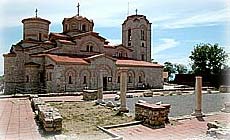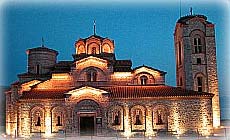
- Geographic location;
Lake Ohrid is the biggest from all lakes in Macedonia covering the deep Southwest border area between Macedonia and Albania. This lake is one of the oldest lakes in the world, the lake is in the group with Lake Caspi, Lake Baikal and the Lake Tanganyka ,with his one unique flora and fauna thats extinct in other parts of the world. Also its has one of cleanest water ecosystems with clear visibility up to 20 meters. The lake is connected with underground water system, witch suply the lake with fresh water, bellow the Galichitsa Mountain with Lake Prespa do to its karstic landscape. Becase of this unique features the lake has been declared a World Heritage site by the UNESCO in the 1979 together with the city of Ohrid.
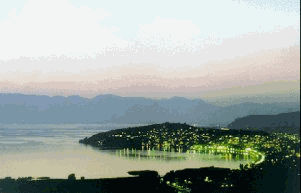 Panoramic view of the lake at sunset.
Panoramic view of the lake at sunset.- The ecosystem;
Lake
Ohrid is a distinctive shelter of large number of freshwater organisms originating from the tertiary period, whose close relatives can be
found in fossil forms only. For precisely this reason it bears the name
"Museum of living fossils". Its remarkable age, continuing existence,
geografic isolation, and the permanency of its living conditions - all
of these together enabled most of its inhabitants to continue the process of their further evolution up to this day. This also made it
possible for the already existing tertiary living forms in the Lake to
further evolve into new taxonomic classes including, subspecies,
species, even entire families of newly evolved organisms.Thus, the
endemism (presence of distinctive, unique organisms), although less
underlined than in Lake Baikal, is the feature of the living world of
Lake Ohrid, comprising 88% of endoparasitic Infusoria (tiny parasitic
organisms), 44% of rabdocelite, and 71% of trikladite (flat worms), 90%
of snails, 66% of small crabs, and 60% of fish.
The so-called intralacustric speciation process, particular for old, deep and large lakes in the world, is on-going in Lake Ohrid and it has encompassed even the fish fauna.The size of the Lake and the quality of its fish fauna underpin its significance in fishing terms. The quality and economic importance of the fish population of the Lake are of a far more higher level than that of the rest of Balkan's lakes, even higher than the shallow and highly productive lakes of the Aegean region.The fish population of Lake Ohrid comprises 17 native species belonging to four families: Salmonidae (2 species), Cyprinidae (12 species), Cobitidae ( 2 species) and Anguillidae (1 species). Ten species are commercially important for the fishing industry, priority being given to the two endemic and relic trout species - Ohrid Trout and Belvica, with Europian Eel and Plasica following the first two. Several analysis have been carried out since 1929. They have shown that the trout and eel account for 45.6% of the catches. That is why the Lake is also called "Trout Lake". The same analysis has shown that the catchment in the Lake Ohrid, in terms of area units, is 9 kg/ha for the Macedonian part of the Lake. This is caused by the low levels of nutrients and is another indicator of its oligotrophic character.
Ohrid
Trout is well-known worldwide and can weight more than 10 kg. However,
in the present conditions in the Lake it reaches the weight of 1 kg in
the seventh year of its life. The latter type of trout, Belvica, is
smaller than the former. It can reach 30 cm in lenghth and weigh up to
one kilogram, but rarely does, since this weight can be reached only in
the twelwth year of its life. The fish Plasica is caught during winter
period and can reach 5 to 15 cm in lenghth. The famous Ohrid Pearl is
produced by using special technology for processing its scales.Alongside these fish species, there are also chub, carp, skobal, grunec, etc.Due
to the main focus on Ohrid Trout in fishing, the Hydrobiological
Institute was founded in the far back past, in the year 1934. Its
establishment, along with the instalation of its reproducing units,
marked the beginnig of Ohrid Trout artificial spawning process aimed at
stocking Lake Ohrid with Ohrid Trout progeny. Ever since this process
has been continuously advanced. Up til now, the Lake has been stocked
by over 520 million pieces of Ohrid Trout offspring cultivated to
various ages and sizes - starting from larvae and up to the age of 18
months. Sexually matured fish caught in the Lake are used in the
process of "artificial spawning". First roe and milt are pressed out
from the fish. Then, they are mixed in the water environment resulting
with in situ insemination of the roe. The inseminated roe is then
transported into the reproducing units and further nurtured before
being stocked into the Lake. The Lake is also stocked with the spawn of
the european eel, a species whose natural production circle has been
discontinued.
The fauna in the Lake also includes freshwater shells, crabs, sponges, etc. There are four types of sponges in the Lake, amongst which is the most famous endemic round Ohrid sponge that lives in 40-50 m depth.
- Something for the nearbay national park Galichitsa;
The lake is a part of the National park Galichitsa, the park covers the area between lake Ohrid and Lake Prespa Galicica has a unique environment with well-preserved natural flora in several ecosystems.The flora in the National Park Galicica covers more than 800 species, among which there are numerous relict and endemic forms whose farthest limit of distribution is Mount Galicica itself. The presence of eleven local endemic forms discovered so way is quite remarkable. These forms exist only on the slopes of the Mount Galicica, and are clear evidence of the specific floral structure of the mountain. It should be underlined that there is an on-going intensive research of the flora in the Park. There are indications of an even greater number of endemic forms.The fauna on Galicica is also prolific and diverse. There are no precise data about the number of invertebrate species. Vertebrates are present with 170 species: 10 amphibians, 18 reptiles, 124 birds, and 18 mammals.
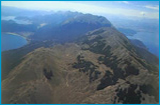 Air view of the Mount Calichitsa.
Air view of the Mount Calichitsa.
The lake has several beaches but the most famous and visited during the summer period are the city beach Slavja, Ljubanishta and Gradishte. The last one has a summer festival with dj sets from local dj's and world famous dj's.
 Ljubanishta beach.
Ljubanishta beach.
- Historical monuments and the nearbay settlements;
Along the shores of the lake there are great numbers of churches and monasterys making the lake area centar of Slavs orthodox religion, the famous nickname of the city of Ohrid 'Slavs Jerusalem' comes from the fact that the number of churches is the same like the number of days in the year. The monastery St.Naum, the resently renovated monastery complex Plaosnik and St. John Kaneo church are most visited religulous objects by the visitors dyring the summer period.
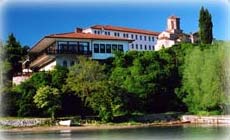 Monestery St. Naum St. John Kaneo
Monestery St. Naum St. John Kaneo 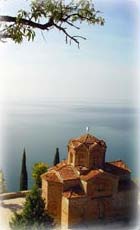
Monestery complex Plaosnik
Along the costline of the lake there are two large cities, Ohrid and Struga, bouth cities are placed on the northern cost. Bouth cities are populated from ancient times becase od their important strategic pozition. The unique features of bouth cities will be showen in separated pages.
